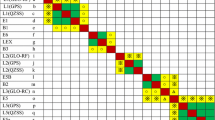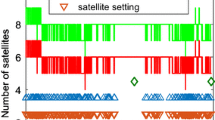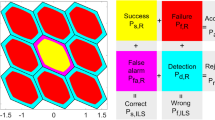Abstract
In positioning, navigation and timing applications of multi-GNSS (global navigation satellite system) constellations, the geometric dilution of precision (GDOP) offers an important index for selecting satellites and evaluating positioning accuracy. However, GDOP assumes that the measurement errors of all the tracked satellites are independent and have the same accuracy level, which is impossible in practice, especially when the tracked satellites are from various constellations. Through introducing a weighted matrix describing the measurement errors of different satellites into a common GDOP, we focus on new characteristics of weighted GDOP (WGDOP) in two aspects. First, we compare the sizes of WGDOP and the common GDOP based on the range of the weights of different satellites, i.e., the diagonal elements of the weighted matrix. In addition, when the weights of different satellites increase, the change of WGDOP with the weights is also derived. Moreover, a closed-form formula for calculating WGDOP is also presented. The theoretical derivations demonstrate that the closed-form can reduce the computation burden effectively. Furthermore, numerical tests verify these analyses.
Similar content being viewed by others
References
Al-Shaery A, Zhang S, Rizos C (2013) An enhanced calibration method of GLONASS inter-channel bias for GNSS RTK. GPS Solut 17(2):165–173
Blanco-Delgado N, Nunes F (2010) Satellite selection method for multi-constellation GNSS using convex geometry. IEEE Trans Veh Technol 59(9):4289–4297
Chen CS (2015) Weighted geometric dilution of precision calculations with matrix multiplication. Sensors 15(1):803–817
Chen CS, Chiu YJ, Lee CT, Lin JM (2013) Calculation of weighted geometric dilution of precision. J Appl Math. https://doi.org/10.1155/2013/953048
Horn RA, Johnson CR (2010) Matrix analysis. Cambridge University Press, Cambridge
Leick A, Rapoport L, Tatarnikov D (2015) GPS satellite surveying, 4th edn. Wiley, New York
Meng FC, Wang S, Zhu BC (2015) GNSS reliability and positioning accuracy enhancement based on fast satellite selection algorithm and RAIM in multiconstellation. IEEE Aerosp Electron Syst Mag 30(10):14–27
Odolinski R, Teunissen PJG, Odijk D (2015) Combined BDS, Galileo, QZSS and GPS single-frequency RTK. GPS Solut 19(1):151–163
Pan L, Cai C, Santerre R, Zhang X (2017) Performance evaluation of single-frequency point positioning with GPS, GLONASS, Beidou and Galileo. Surv Rev 49(354):197–205
Teng YL, Wang J (2014) New characteristics of geometric dilution of precision (GDOP) for multi-GNSS constellations. J Navig 67(6):1018–1028
Teng YL, Wang J (2016a) Some remarks on PDOP and TDOP for multi-GNSS constellations. J Navig 69(1):145–155
Teng YL, Wang J (2016b) A closed-form formula to calculate geometric dilution of precision (GDOP) for multi-GNSS constellations. GPS Solut 20(3):331–339
Teunissen PJG, Odolinski P, Odijk D (2014) Instantaneous Beidou + GPS RTK positioning with high cut-off elevation angles. J Geodesy 88(4):335–350
Wang J, Knight N, Lu N X (2011) Impact of the GNSS time offsets on positioning reliability. J GPS 10(2):165–172
Won DH, Ahn J, Lee SW, Lee J, Sung S, Park HW, Park JP, Lee YJ (2012) Weighted DOP with consideration on elevation-dependent range errors of GNSS satellites. IEEE Trans Instrum Meas 61(12):3241–3250
Acknowledgements
This work is supported by the National Natural Science Foundation of China under Grant nos. 61603075 and 51277022, and the Scientific Research Fund of Science & Technology Department of Sichuan Province under Grant no. 2018JY0239.
Author information
Authors and Affiliations
Corresponding author
Appendix
Appendix
The proof of (9) will be clarified in this section. Let \({\varvec{A}},\;{\varvec{B}} \in {R^{K \times K}}\) be the two symmetric positive matrices and let the eigenvalues \({\lambda _i}\left( {\varvec{A}} \right),\;{\lambda _i}\left( {\varvec{B}} \right)\), \({\lambda _i}\left( {{\varvec{A}}+{\varvec{B}}} \right)\) be arranged in increasing order. For any nonzero vector \({\varvec{v}} \in {R^K}\), we have the bound
and hence for any \(1 \leq i \leq \;K\) we have
which can be further transformed as
Considering the fact that the matrix \({\varvec{B}}\) is a symmetric positive one, namely, its eigenvalues are all positive, then we can obtain
Assuming that \({\varvec{A}}={\varvec{H}}_{N}^{T}{\vec {{\varvec{W}}}_N}{{\varvec{H}}_N}\)and \({\varvec{B}}={\varvec{H}}_{N}^{T}\left( {{{\varvec{I}}_N} - {{\vec {{\varvec{W}}}}_N}} \right){{\varvec{H}}_N}\) in (44), then we can obtain the desired statement in (9).
End of proof.
Rights and permissions
About this article
Cite this article
Teng, Y., Wang, J., Huang, Q. et al. New characteristics of weighted GDOP in multi-GNSS positioning. GPS Solut 22, 74 (2018). https://doi.org/10.1007/s10291-018-0740-z
Received:
Accepted:
Published:
DOI: https://doi.org/10.1007/s10291-018-0740-z




